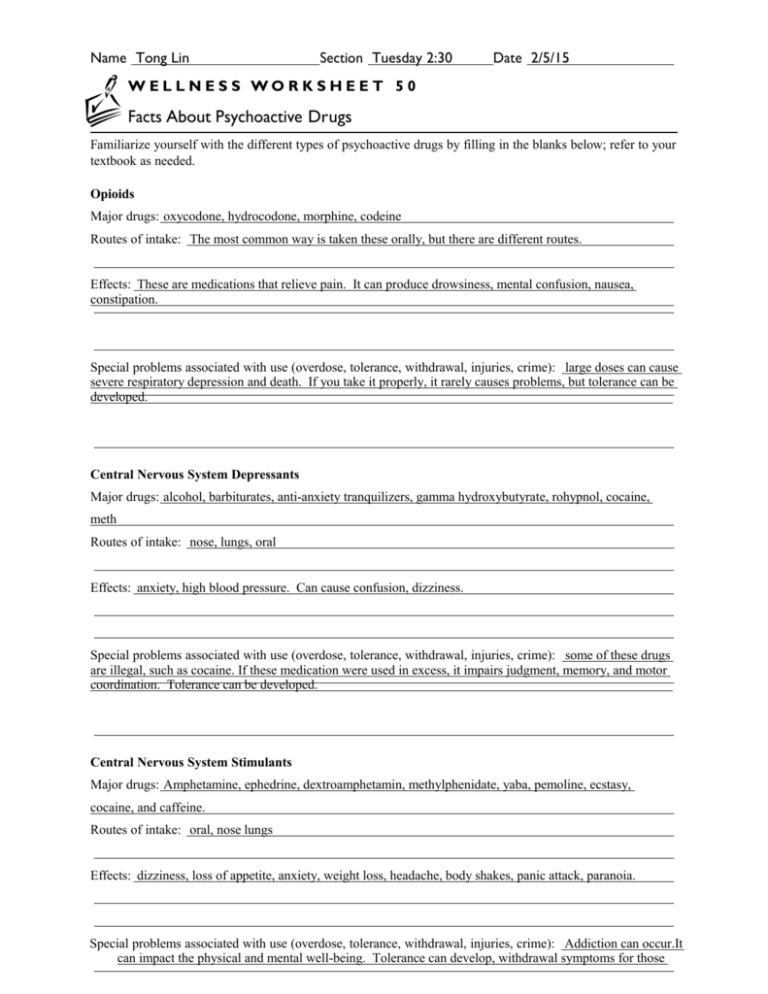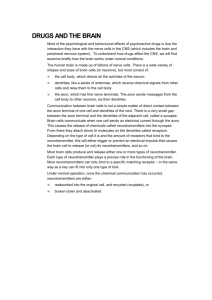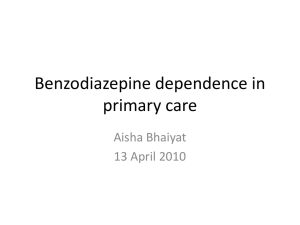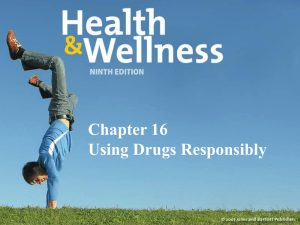File
advertisement

Name Tong Lin Section Tuesday 2:30 Date 2/5/15 W EL L NES S WO R KSHEE T 50 Facts About Psychoactive Drugs Familiarize yourself with the different types of psychoactive drugs by filling in the blanks below; refer to your textbook as needed. Opioids Major drugs: oxycodone, hydrocodone, morphine, codeine Routes of intake: The most common way is taken these orally, but there are different routes. Effects: These are medications that relieve pain. It can produce drowsiness, mental confusion, nausea, constipation. Special problems associated with use (overdose, tolerance, withdrawal, injuries, crime): large doses can cause severe respiratory depression and death. If you take it properly, it rarely causes problems, but tolerance can be developed. Central Nervous System Depressants Major drugs: alcohol, barbiturates, anti-anxiety tranquilizers, gamma hydroxybutyrate, rohypnol, cocaine, meth Routes of intake: nose, lungs, oral Effects: anxiety, high blood pressure. Can cause confusion, dizziness. Special problems associated with use (overdose, tolerance, withdrawal, injuries, crime): some of these drugs are illegal, such as cocaine. If these medication were used in excess, it impairs judgment, memory, and motor coordination. Tolerance can be developed. Central Nervous System Stimulants Major drugs: Amphetamine, ephedrine, dextroamphetamin, methylphenidate, yaba, pemoline, ecstasy, cocaine, and caffeine. Routes of intake: oral, nose lungs Effects: dizziness, loss of appetite, anxiety, weight loss, headache, body shakes, panic attack, paranoia. Special problems associated with use (overdose, tolerance, withdrawal, injuries, crime): Addiction can occur.It can impact the physical and mental well-being. Tolerance can develop, withdrawal symptoms for those who stop taking the substance, depression, and suicidal thoughts. (over) Insel/Roth, Connect Core Concepts in Health, Twelfth Edition © 2012 The McGraw-Hill Companies, Inc. Chapter 9 Insel/Roth, Connect Core Concepts in Health, Brief Twelfth Edition © 2012 The McGraw-Hill Companies, Inc. Chapter 7 WELLNESS WORKSHEET 50 — continued Marijuana and Other Cannabis Products Major drugs: marijuana Routes of intake: Marijuana is usually smoked. Effects: Marijuana is addicting. It causes fatigue, paranoia, possible psychosis, memory problems, depersonalization, and mood alterations. Special problems associated with use (overdose, tolerance, withdrawal, injuries, crime): Tolerance may develop after couple doses. There are prescribed marijuana. It is illegal in many states. Excessive use can cause addiction. Hallucinogens Major drugs: LSD, peyote, psilocybin, PCP Routes of intake: can be taken orally, injection, smoked, or sniffed. Commonly taken by oral. Effects: see images, hear sounds, and feel sensations, anxiety, dizziness, loss of coordination. Special problems associated with use (overdose, tolerance, withdrawal, injuries, crime): Overdose is very severe, it can cause lung failure, coma, and even death. Tolerance can develop quickly if use excessively. No withdrawal. Inhalants Major drugs: Inhalants may include volatile solvents, aerosols, gases, and nitrites. Routes of intake: nose, oral Effects: nausea, vomiting, liver and kidney damage, hearing loss, or bone marrow damage. It can be deadly if smoked highly concentrated chemicals. Special problems associated with use (overdose, tolerance, withdrawal, injuries, crime): symptoms of overdose include hallucinations, drowsiness and coma. People who use inhalants regularly can develop dependence and tolerance to them. Withdrawal symptoms which can include nausea, excessive sweating, muscle cramps, headaches, chills. Laws exist in some US states prohibiting the recreational inhalants.








